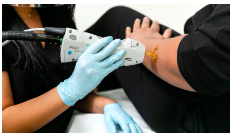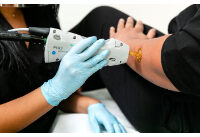Laser Hair Removal – What You Need to Know
Best Laser Hair Removal Langley removes unwanted body hair by using heat to destroy the hair follicle. It’s less painful than tweezing, shaving, and waxing. Most men and women require six to eight treatments, spaced four to eight weeks apart. It works best on people with light skin and dark hair, as the pigment contrast makes it easier for the laser to target hair follicles and destroy them.
Laser hair removal is a great way to save time and money by eliminating the need for shaving and waxing. But if you want the best results possible from your session, it’s important to follow all of the pre-treatment orders from your technician. Not following these instructions can reduce the effectiveness of your session and even cause serious complications.
Before your treatment, you’ll need to clean the area of skin where you’re having it done and remove any makeup or other products from the area. Lotions, creams, and other products can heat up faster than your skin and cause burns during the laser process. They can also make it difficult for the laser to target the hair follicles and can result in hairs being missed or damaged during your session.
It’s also a good idea to avoid sun exposure and tanning before your treatment. Tanning makes your skin darker, and the laser will be unable to distinguish between the color of your hair and the color of your skin. You should also avoid other forms of hair epilation such as plucking and waxing for six weeks before your session. This helps ensure that the hair follicles aren’t already dead when they’re targeted by the laser.
During your treatment, your technician will apply a numbing gel to the skin and then give it a pulse of light. The sensation from this is described as a warm pinprick or a rubber band snapping against the skin, and most patients find it to be less painful than other methods of hair removal such as waxing and threading. After your treatment, you’ll need to apply anti-inflammatory lotion or over-the-counter hydrocortisone cream to the treated area, and you may experience redness or swelling for a few hours after your appointment.
It’s a good idea to avoid exercising or taking hot showers or baths in the days following your treatment, as this can make your skin irritated and can increase the likelihood of infection. You’ll also want to wait at least 24 hours before you resume using any skin care products that contain certain ingredients such as benzoyl peroxide, salicylic acid, and retinol. Some medications can interfere with your laser treatment or make you more sensitive to the effects of it, so be sure to tell your technician about any medications or supplements that you take.
Treatment
Hair removal lasers emit a light beam that’s attracted to pigment, or color, in the hair in your skin. The light is then converted to heat, which destroys the hair follicle. As a result, the follicle cannot produce any more hair and the growth cycle is interrupted. The laser technology is precise and effective, so your technician can treat only the follicles that contain hair — leaving the surrounding skin undamaged.
Before your session, your technician will trim and shave the area to prepare it for treatment. Then they will apply a topical numbing cream or gel to the skin, which helps ease any discomfort from the laser pulses. You might experience itching, redness or swelling after treatment; this is normal and can be reduced by using a cold compress. It’s also important to avoid exposing the treated area to direct sunlight after your procedure; use sunscreen with an SPF of 30 or higher.
During the procedure, your technician will pass the laser over the targeted area of skin several times. They might also adjust the device based on your skin tone and hair color to get the best results. The laser treatment is quick, but it may take up to an hour for a large area like your back or legs.
Your hair will grow back over time, but it should be much lighter and finer than before. Even though the laser permanently damages the hair follicle, it’s difficult to destroy every single one of them, especially in people with dark skin. It’s important to continue to see your dermatologist for touch-up treatments at four to six week intervals until you have a permanent solution to unwanted hair.
Remember, laser hair removal is a medical procedure that requires training to perform safely. Make sure your doctor or technician is a licensed professional and belongs to a register that shows they meet set standards of skill and safety. You should also check with your insurance to determine whether the procedure is covered by your policy. If not, you can use a flexible spending account or payment plan to cover the cost of laser treatments.
Recovery
Laser hair removal can be a fast and relatively pain-free procedure, especially if you take steps to minimize discomfort. For instance, you should avoid plucking and waxing for about six weeks before treatment because those activities temporarily remove the hairs’ roots. You should also limit sun exposure because it makes laser hair removal less effective and increases the chances of complications after the procedure. If you do suffer discomfort after a laser hair removal session, apply a cold compress or an ice pack wrapped in a dry cloth several times per day to soothe the area. You can also use a topical anesthetic to reduce discomfort, which is often offered by dermatologists.
Immediately after laser hair removal, the treated skin will have a puffiness and redness, which are common side effects of laser treatment. You should wait until the puffiness and redness fade before you shave the area, because shaving can cause razor burn. It’s a good idea to use gentle moisturizers on the area as well. If your doctor has instructed you to avoid sun exposure, wear sunscreen on the area as well.
After four weeks, you should begin to notice a reduction in hair growth. This is because the hair follicles will have been destroyed by the heat from the laser and they will begin to shed as they die. This shedding is what causes the appearance of reduced hair growth after laser treatment.
Hair will continue to grow back from damaged follicles, but it should be lighter in color and less noticeable than before. This is because the light from the laser disrupts the melanin in the hair follicle, so it no longer produces dark, unwanted hair.
It takes six to eight sessions to achieve long-lasting results from laser hair removal. You may need to come in for touch-up treatments once or twice a year to maintain the desired result. If you have darker hair and lighter skin, it might take even more treatments than this to see a difference. However, after a series of treatments, you can expect a significant reduction in hair growth and the ability to stop shaving, waxing or plucking completely.
Maintenance
Unwanted hair can be a significant problem for many people, leading to feelings of self-consciousness. Waxing, tweezing and plucking are time-consuming and only provide short-lived results. Fortunately, laser hair removal is a simple and fast process that can permanently reduce the amount of hair growth on any part of the body.
During the treatment, the laser’s thermal energy targets and damages the pigmentation within the base of the hair follicle. This causes the follicle to die and prevents future hair growth. Your skin will look red and swollen after the treatment – this feels similar to a sunburn and can last for a few hours. However, the redness and swelling will eventually subside.
A series of follow-up treatments is usually necessary for optimal results. The number of sessions required depends on your skin tone, hair color and area of the body being treated. In addition to your dermatologist’s guidance, it is important to wear sunscreen with an SPF of 30 or higher at all times and avoid tanning in the days before and after your treatment.
It is also important to attend your treatment appointments consistently to maximize the effectiveness of the procedure. If you miss a treatment appointment, the hair follicles may recover and begin growing again. This will significantly slow down your progress and prevent you from achieving the desired results.
The best way to keep your skin in great condition is to make sure it stays hydrated and moisturized in between laser hair removal sessions. Using a gentle soap or cleanser with warm water can help to exfoliate the surface of your skin and encourage the shedding of dead hairs. It is also essential to keep the area of your body that has been treated away from direct sunlight, especially during the first few weeks following your appointment.
While most people are able to achieve permanent hair reduction with just one round of laser treatments, you will likely need to have regular maintenance appointments in order to keep the hair follicles from regrowing hair and compromising your results. These maintenance appointments are usually scheduled 4-6 weeks apart and are determined by the natural cycle of your hair.






